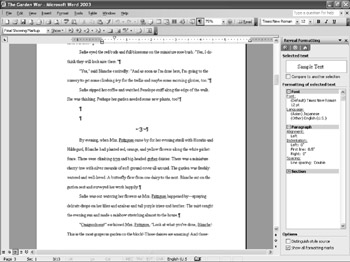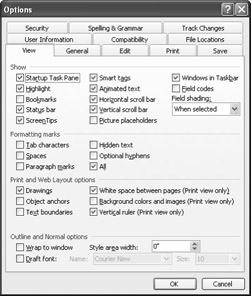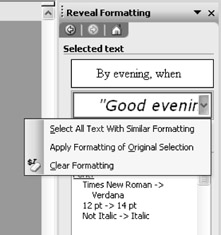Seeing What s Going On Using Reveal Formatting
|
| < Day Day Up > |
|
Seeing What's Going On Using Reveal Formatting
You can find out how text at the cursor position is formatted by choosing Format, Reveal Formatting to display the Reveal Formatting task pane, shown in Figure 7-7.

Figure 7-7: The Reveal Formatting task pane lists the format settings for the text at the insertion point.
The Reveal Formatting task pane lists all the format specifications for the selected text. The format items are divided into three groups:
-
Font This group includes format settings that apply to the characters used in the document, including the font type and size, as well as the language selected for the document.
-
Paragraph This group contains format settings for aspects of the paragraph such as the selected paragraph style, text alignment, indentation settings, and paragraph spacing (before and after spacing, as well as line spacing).
-
Section This group includes the format settings you use to control larger portions of the document, including overall margin settings, page layout choices, and paper selections.
Making Changes from the Reveal Formatting Task Pane
You can make formatting changes to the text at the insertion point right from the Reveal Formatting task pane. By simply clicking the format setting you want to change (the links are shown in blue, underlined text), you can move directly to the relevant dialog box. To make formatting changes directly from the task pane, follow these steps:
-
Select the text for which you want to change the format.
-
Choose Format, Reveal Formatting. The Reveal Formatting task pane appears.
-
Click the format setting you want to change. For example, click the Indentation link in the task pane. The Paragraph dialog box appears with the Indents And Spacing tab displayed, as shown in Figure 7-8.

Figure 7-8: You can save time and effort by moving directly to the changes you want to make from the Reveal Formatting task pane. -
Make your changes and close the dialog box. You are returned to the current document.
Displaying Formatting Marks from Reveal Formatting
For times when you need to grab the last paragraph mark, move blocks of text from one section to another, or make sure you have only one space between words, you can display and work with formatting marks in your document.
You can display formatting marks easily from the Reveal Formatting task pane by selecting the Show All Formatting Marks check box at the bottom of the task pane. The marks then appear in your document, as shown in Figure 7-9.

Figure 7-9: Display formatting marks by selecting the check box at the bottom of the Reveal Formatting task pane.
Changing the Formatting Marks That Appear
By default, all available formatting marks—tabs, spaces, paragraph marks, hidden text, and hyphens—are shown when you select Show All Formatting Marks in the Reveal Formatting task pane. You can change which marks are displayed by following these steps:
-
Choose Tools, Options. The Options dialog box appears, as shown in Figure 7-10.

Figure 7-10: Switch to the View tab in the Options dialog box to change which formatting marks are displayed. -
Click the View tab, if necessary. In the Formatting Marks section, select check boxes for the marks you want to appear in the document.
Tip Avoid screen clutter Some people are able to work with formatting marks on and barely notice them; others are distracted by the dots and symbols stuffed between words and paragraphs in their text. You can hide formatting marks quickly by clicking the Show/Hide button on the Standard toolbar.
Comparing Other Text Formats
Another option available to you in the Reveal Formatting task pane is the ability to compare and contrast similar text styles with subtle differences. Have you ever studied a heading, wondering why it doesn't look quite right compared to another heading in your document? Now Reveal Formatting enables you to click on one text item, and then compare it to another, showing the differences in font styles and sizes, spacing, and so forth.
To compare the formats of two text segments in your document, follow these steps:
-
Select the text you want to start with. You can either select a block of text or simply place the insertion point in the text you want to use.
-
Display the Reveal Formatting task pane, if needed, by choosing Format, Reveal Formatting.
-
Select the Compare To Another Selection check box, just beneath the Selected Text box in the Reveal Formatting task pane. Another text selection box opens in the task pane, showing a duplicate of the text you selected.
-
Now select the text to which you want to compare the original text. The task pane shows the formatting differences between the two selections, as shown in Figure 7-11.

Figure 7-11: The Reveal Formatting task pane displays the formatting differences between two text selections.Tip The Reveal Formatting task pane is perfect for comparing the format of one piece of text with another. But when you want to see and compare the contents of documents (and not just the format), choose Compare Side By Side from the Window menu to view two open documents together on the screen.
Making Changes in Text Under Comparison
Suppose that comparing two different types of heading reveals the need to reformat one type of heading throughout your entire document. Word gives you a way to do this easily. Right there in the Reveal Formatting task pane, you can choose an option that will modify every heading formatted with particular settings in the rest of your document. To make this kind of change, follow these steps:
-
Click the arrow to the right of the compared text. A menu appears, as shown in Figure 7-12.

Figure 7-12: Select the action in the Reveal Formatting task pane.You can choose Select All Text With Similar Formatting, which highlights all text in the document with the same specifications; Apply Formatting Of Original Selection, which applies the format of the first item to the second item; or Clear Formatting, which clears the formatting of the second Selected Text item.
Tip Find similar formats When the Reveal Formatting task pane is not visible, you can easily find and highlight all text with the same format as the text at the insertion point. Just right-click the text and choose Select Text With Similar Formatting from the shortcut menu. All similar text items throughout your document will be selected, and you can make your changes as needed.
-
Choose the option you want, and then Word reformats the text accordingly. If you don't like the change, choose Edit, Undo to reverse your changes.
One final offering in the Reveal Formatting task pane that's worth a mention: you can find out the source of a particular style by selecting the Distinguish Style Source check box at the bottom of the Reveal Formatting task pane.
Selecting this check box causes Word to display the style from which the new style was created; for example, if a Note style applied to a segment of text in your document was created based on your Body Text style, the task pane will show you that information. That's helpful to know if you're planning to change the Body Text style at some point—you'll be able to see at a glance which other items in your document will be affected by the change.
|
| < Day Day Up > |
|
EAN: 2147483647
Pages: 373